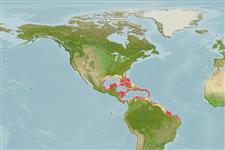>
Ovalentaria/misc (Various families in series Ovalentaria) >
Pomacentridae (Damselfishes) > Microspathodontinae
Etymology: Stegastes: Greek, stegastos, -e, -on = covered (Ref. 45335).
More on author: Poey.
Environment: milieu / climate zone / distribuzione batimetrica / distribution range
Ecologia
marino associati a barriera corallina; non migratori; distribuzione batimetrica 0 - 100 m (Ref. 9626). Tropical; 33°N - 5°S, 98°W - 34°W
Western Atlantic: including southern Florida (USA), Bahamas, and the Caribbean. Probably extending to Brazil (Ref. 9626).
Size / Peso / Age
Maturità: Lm ? range ? - ? cm
Max length : 10.0 cm TL maschio/sesso non determinato; (Ref. 26340)
Short description
Chiavi di identificazione | Morfologia | Morfometria
Spine dorsali (totale) : 12; Raggi dorsali molli (totale) : 14 - 17; Spine anali: 2; Raggi anali molli: 13 - 15. Exhibits geographic color variations (Ref. 7247). Body dark in front, becoming abruptly yellow between last dorsal spine and anal fin origin (Ref. 26938).
Body shape (shape guide): fusiform / normal; Cross section: compressed.
Adults inhabit shallow coral reefs and isolated patch reefs in deeper water. Feed primarily on algae but also on polychaetes, hydroids, copepods and ascidians (Ref. 9626). Aggressively territorial but only around a small area (Ref. 9710). Oviparous, distinct pairing during breeding (Ref. 205). Eggs are demersal and adhere to the substrate (Ref. 205). Males guard and aerate the eggs (Ref. 205). Taken incidentally in traps and small-meshed beach nets (Ref. 5217).
Life cycle and mating behavior
Maturità | Riproduzione | Deposizione | Uova | Fecundity | Larve
Oviparous, distinct pairing during breeding (Ref. 205). Eggs are demersal and adhere to the substrate (Ref. 205). Males guard and aerate the eggs (Ref. 205). This species has a juvenile bisexual condition and a typical gonochore testis (Ref. 103751).
Allen, G.R., 1991. Damselfishes of the world. Mergus Publishers, Melle, Germany. 271 p. (Ref. 7247)
IUCN Red List Status (Ref. 130435: Version 2025-1)
Threat to humans
Harmless
Human uses
Pesca: commerciale; Acquario: Commerciale
Strumenti
Special reports
Download XML
Fonti Internet
Estimates based on models
Preferred temperature (Fonte Biblio.
123201): 24.2 - 28, mean 26.9 °C (based on 262 cells).
Phylogenetic diversity index (Fonte Biblio.
82804): PD
50 = 0.5000 [Uniqueness, from 0.5 = low to 2.0 = high].
Bayesian length-weight: a=0.01230 (0.00566 - 0.02674), b=3.06 (2.86 - 3.26), in cm total length, based on LWR estimates for this species & (Sub)family-body (Ref.
93245).
Trophic level (Fonte Biblio.
69278): 2.0 ±0.00 se; based on food items.
Resilienza (Fonte Biblio.
120179): Alto, tempo minimo di raddoppiamento della popolazione meno di 15 mesi (Preliminary K or Fecundity.).
Fishing Vulnerability (Ref.
59153): Low vulnerability (10 of 100).
🛈
Nutrients (Ref.
124155): Calcium = 123 [65, 204] mg/100g; Iron = 0.889 [0.533, 1.467] mg/100g; Protein = 18.2 [17.1, 19.3] %; Omega3 = 0.157 [0.098, 0.256] g/100g; Selenium = 30.7 [16.8, 59.7] μg/100g; VitaminA = 111 [31, 375] μg/100g; Zinc = 2.37 [1.62, 3.37] mg/100g (wet weight);
